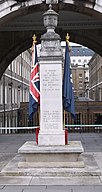Wikipedia:Main Page history/2024 January 27b
From today's featured article
The Civil Service Rifles War Memorial is a First World War memorial located at Somerset House in London, England. Designed by Sir Edwin Lutyens and unveiled by Edward, Prince of Wales, in 1924, the memorial commemorates the 1,240 members of the Prince of Wales' Own Civil Service Rifles regiment killed in the war. The memorial takes the form of a rectangular column surmounted by a sculpture of an urn and flanked by painted stone flags, a feature seen in other memorials by Lutyens. A scroll of the names of the fallen was placed inside the memorial. Those who served in the regiment were Territorial Force reservists, drawn largely from the British Civil Service with many staff based in Somerset House. The memorial was initially located in the quadrangle, which had been used by the regiment as a parade ground. It was later moved to the riverside terrace and rededicated in 2002. Upgraded to Grade II* listed-building status in 2015, it forms part of a national collection of war memorials by Lutyens. (Full article...)
Did you know ...
- ... that locals responding to the 1882 Spuyten Duyvil train wreck used snowballs to extinguish the fires in the wrecked cars (illustration pictured)?
- ... that the rapper Jords did not know his father was a musician until a chance encounter in a British supermarket?
- ... that the Lunar Ejecta and Meteorites Experiment continuously overheated and had to be switched off during lunar noon?
- ... that Nelson Santana supposedly predicted the date of his death?
- ... that anti-Korean sentiment, due to South Korea's economic growth, motivated Djuna to write the sci-fi novel Counterweight?
- ... that jazz saxophonist Chris Byars ended his childhood operatic career when his voice croaked during a performance?
- ... that years after it closed, the studios of an Iowa TV station became the headquarters for the state police radio network?
- ... that Frederick Murray Trotter had a distinguished career as a field geologist despite losing a part of his skull and an eye to shrapnel during World War I?
In the news
- Following damage to the helicopter's rotors, NASA ends the Ingenuity (pictured) mission on Mars after almost three years and seventy-two flights.
- The Ram Mandir, a temple to Rama, is consecrated at a disputed site in Ayodhya, India.
- Japan Aerospace Exploration Agency's lunar module SLIM lands on the Moon.
- Protests break out in Bashkortostan, Russia, following the imprisonment of environmental activist Fail Alsynov.
- Iran launches missile strikes in Pakistan and aerial strikes in Iraq and Syria, and Pakistan responds with retaliatory airstrikes.
On this day
- 1799 – French Revolutionary Wars: In the Macau Incident, French and Spanish warships encountered a British Royal Navy escort squadron in the Wanshan Archipelago; subsequent events, including which side retreated, were disputed by the commanders present.
- 1996 – Mahamane Ousmane (pictured), the first democratically elected president of Niger, was deposed by Colonel Ibrahim Baré Maïnassara in a military coup d'état.
- 2003 – The first selections for the United States National Recording Registry were announced by the Library of Congress.
- 2011 – Astronomers documented H1504+65, a white dwarf in Ursa Minor with the hottest surface temperature known at the time, at 200,000 kelvins (360,000 °F).
- Titumir (b. 1782)
- Mohamed Al-Fayed (b. 1929)
- Victoria Ocampo (d. 1979)
- Paul Zorner (d. 2014)
Today's featured picture

|
The Indian pied myna (Gracupica contra) is a species of starling found in the Indian subcontinent, with a principal distribution from the Gangetic plains extending south to the Krishna River. This range has increased in recent times, with populations established in Pakistan, western India and also Dubai. The spread has been aided by changes in irrigation and farming patterns and accidental escape of caged birds. The Indian pied myna is found mainly in lowland open areas with scattered trees near water, often near human habitation, but also inhabits areas up to around 700 metres (2,300 ft) in altitude. It has a black-and-white plumage with a yellowish bill and a reddish bill base. This pair of Indian pied mynas was photographed outside the city of Hapur in Uttar Pradesh, India. Photograph credit: Charles J. Sharp
Recently featured:
|
Other areas of Wikipedia
- Community portal – The central hub for editors, with resources, links, tasks, and announcements.
- Village pump – Forum for discussions about Wikipedia itself, including policies and technical issues.
- Site news – Sources of news about Wikipedia and the broader Wikimedia movement.
- Teahouse – Ask basic questions about using or editing Wikipedia.
- Help desk – Ask questions about using or editing Wikipedia.
- Reference desk – Ask research questions about encyclopedic topics.
- Content portals – A unique way to navigate the encyclopedia.
Wikipedia's sister projects
Wikipedia is written by volunteer editors and hosted by the Wikimedia Foundation, a non-profit organization that also hosts a range of other volunteer projects:
-
Commons
Free media repository -
MediaWiki
Wiki software development -
Meta-Wiki
Wikimedia project coordination -
Wikibooks
Free textbooks and manuals -
Wikidata
Free knowledge base -
Wikinews
Free-content news -
Wikiquote
Collection of quotations -
Wikisource
Free-content library -
Wikispecies
Directory of species -
Wikiversity
Free learning tools -
Wikivoyage
Free travel guide -
Wiktionary
Dictionary and thesaurus
Wikipedia languages
This Wikipedia is written in English. Many other Wikipedias are available; some of the largest are listed below.
-
1,000,000+ articles
-
250,000+ articles
-
50,000+ articles




